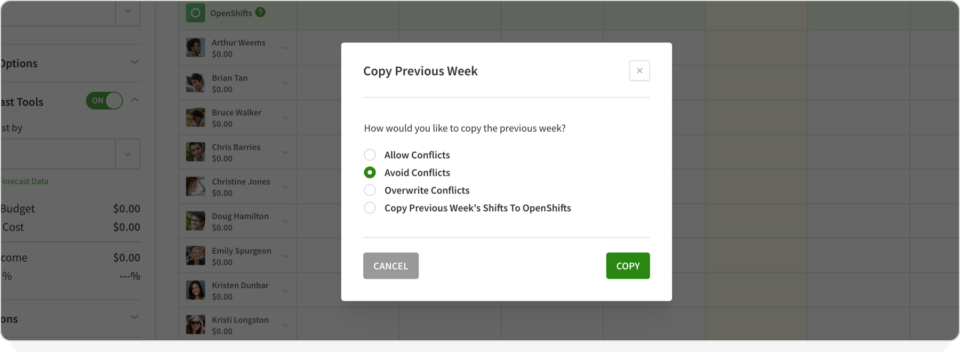How To Fill Shifts In Advance
Try When I Work for free
Are your shifts constantly facing coverage gaps? Learning how to fill shifts in advance can make shortages a distant memory. You’ll also improve employee morale and make sure you’ve got the staff members to keep customers happy.
The best part is you don’t have to rely on manual processes to build out your schedule multiple weeks in advance. Instead, you can use When I Work. Our scalable, cost-effective automatic scheduling software solution makes life easy for businesses of all sizes. Try it free and take the hassle out of employee scheduling.
Here are the key things you need to know about how to fill shifts in advance:
- Advanced scheduling ensures adequate shift coverage
- Accommodating your staff’s availability can boost morale
- Keeping team members happy can reduce callouts
- Automating your scheduling processes saves time and reduces errors
- Including your team in the scheduling process can make them feel heard
Table of contents
- Why is it important to create the employee schedule in advance?
- How to fill shifts in advance
- Filling shifts in advance with When I Work
Why is it important to create the employee schedule in advance?
Scheduling employees in advance represents a critical part of shift planning. By looking ahead, you can reduce the risk of last-minute conflicts. You can also make sure you’ve got enough team members to meet the company’s needs.
Here are all the things advance scheduling helps you accomplish:
Ensure adequate coverage
You must make sure there are enough workers on each shift to fulfill all responsibilities. Planning ahead helps accommodate fluctuating coverage needs throughout the week and avoid shortages.
Occasionally working short-handed comes with the territory of shift work. However, putting your team in this position all the time can crush morale.
For example, imagine you manage a restaurant. Your business is busiest on Friday nights, which means you need to schedule more workers for those shifts. That way, customers get great service, and the restaurant can handle the rush.
If you don’t have enough people working, it can lead to long wait times. Customers will likely get frustrated, and your reputation might suffer. Having a full team ready to go helps keep things running smoothly.
Accommodate for your staff’s availability
Shift work can provide a lot of flexibility. However, early morning or late night shifts can put a strain on some employees, especially those with young children or personal obligations.
Scheduling workers in advance will help you account for changes in availability. Your team members will also have more time to review their upcoming shifts. They can use this extra time to obtain childcare or trade assignments with coworkers.
Let’s say one of your team members can only work afternoon shifts because they have classes in the morning. You need to make sure you schedule them for afternoon shifts. If you’re in a rush to put together a schedule, you might forget about their morning obligations and make a mistake.
Minimize the risk of no-shows and late arrivals
Telling people about their shift obligations at the last minute can increase the risk of no-shows or late arrivals. On the other hand, if you create schedules in advance, workers can plan their days accordingly.
Let’s say you fall behind on scheduling and don’t release shift assignments until two days before the new work week. One employee finds out they’ve got to open the restaurant two days from now. However, they’ve already got late-night plans for the evening prior. In this scenario, they may call out or show up late for their shift.
Improve employee satisfaction and work-life balance
According to Intuit, 20% of employers give their workers less than a week’s notice of work schedules. Researchers also found that 55% of shift workers say they need more notice about upcoming shifts than their bosses typically provide.
Breaking away from this trend can improve employee satisfaction and give your team a better work-life balance. If team members have multiple weeks’ notice about upcoming shifts, they can plan their activities and hobbies around work obligations. They’ll be happy that they get to engage in fulfilling activities without creating work conflicts.
Happy employees will be more productive and motivated. They may also be less prone to quitting or missing shifts.
How to fill shifts in advance
Creating your schedules ahead of time is easier than you might expect. All you need to do is follow these simple steps:
1. Create a consistent scheduling routine
If your team works rotating schedules or fluctuating shifts, it’s important to provide them with a sense of continuity. Being consistent about how you create schedules and when you publish them can do just that.
Say your schedules always start on Mondays and end on Sundays. In this scenario, you could designate Monday morning as the time to create schedules and publish shifts every Monday afternoon. To ensure your team has plenty of notice, you should publish shifts at least two weeks in advance.
By adopting this simple practice, you can give workers peace of mind knowing they’ll find out their schedule every Monday afternoon. Additionally, they will have two full weeks to trade shifts or make childcare arrangements.
2. Determine your business’s coverage needs
Next, you need to determine how much coverage your business needs each day. Map out the work week and break each day into morning and evening shifts. If you have mid-day or overnight needs, include those too. List how many workers you need for each shift. Break this list down by role (e.g., host, cook, server).
Write down each employee’s name, position, and how many hours they can work each week. From there, start filling in vacancies on your schedule.
Be fair with your scheduling practices. For instance, evening shift workers often make more money through tips or differentials. Try to give everyone at least some evening shifts (unless their availability prevents them from working late).
3. Cross-compare with employee availability and preferences
It’s essential to consider each worker’s preferences and availability during your scheduling process. Some people may prefer evenings, while others want to work mostly mornings. If you can accommodate these preferences, do it.
Also, incorporate fluctuating availability limitations, like approved time-off requests, into your schedule. The last thing you want is to accidentally schedule someone who will be on vacation.
Fortunately, applications like When I Work automatically track time off and prevent you from including these individuals in the schedule. That way, you can easily respect worker’s requests while avoiding scheduling errors.
4. Get feedback from your staff
After you’ve outlined the basics of how to fill shifts in advance, talk to your team about your plans. Find out how much notice they need (two weeks, one month, etc.) and try to accommodate reasonable requests.
Invite them to provide constructive criticism. Ask them to provide insights as to what you should do differently. You never know what great ideas and suggestions you’ll receive when everyone has a voice.
5. Use schedule templates
Templates make shift scheduling plug-and-play. You won’t have to start from scratch each week. Instead, you’ll have a clear visual of how many vacancies you need to fill for each day and shift. You can start putting workers in their preferred spots and then fill in any gaps caused by time-off requests or availability limitations.
There are a few ways to go about adopting templates. You can build your own spreadsheet software or take advantage of free options, such as those When I Work offers.
If you don’t want to bother with spreadsheets, When I Work is the more user-friendly option. Our platform has customizable templates, auto-fill features, and much more.
6. Invest in employee scheduling software to automate the process
Scheduling software represents the next step in your employee management journey. With the right tools at your fingertips, you’ll save countless hours each week and keep your team happy by accommodating their availability.
When I Work scheduling software automates many aspects of planning shifts in advance. It uses custom templates and employee data to build out complete, error-free schedules in minutes.
By switching to When I Work, you’ll take the hassle out of advanced shift planning. The platform also provides insights into labor costs and robust reporting tools to maximize revenue.
Filling shifts in advance with When I Work

When I Work employee scheduling software makes it easy to fill shifts in advance.
Once you set up the platform and put in your employee data, you’ll be able to effortlessly create new schedules using customizable templates. You can create schedules weeks in advance, automatically account for approved time-off requests, and respect employees’ availability limitations.
That’s not all. When I Work has tons of other features to make life easier for you and your team. The built-in messaging app makes it easy to share schedule updates and communicate with your staff and you can use the time clock feature to track hours.
When I Work helps you save time when you create the schedule
Learning how to fill shifts in advance without bogging yourself down with administrative tasks can make your business far more efficient.
Your team members will be happier, as they’ll know when they need to be at work and can plan accordingly. But your customers will reap the most benefits. You’ll have the staff necessary to accommodate their needs in a timely manner and promote their overall satisfaction.
While you can fill shifts in advance the old-fashioned way, scheduling software provides a much better option. With When I Work, you’ll enjoy automation tools, communication capabilities, and all the resources necessary to plan shifts like a pro.
Check out When I Work, the advanced scheduling solution for growing businesses. Sign up for a free14-day trial today.






